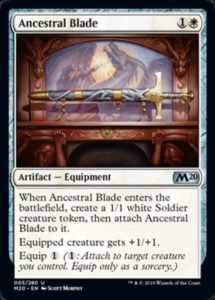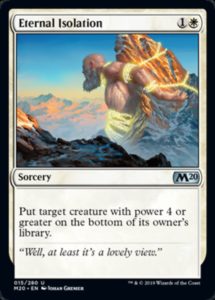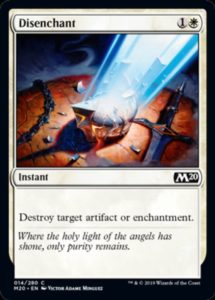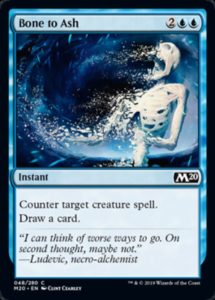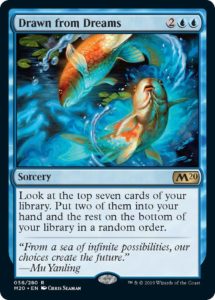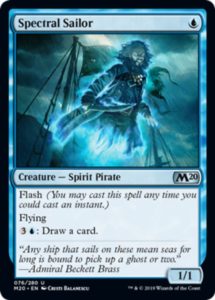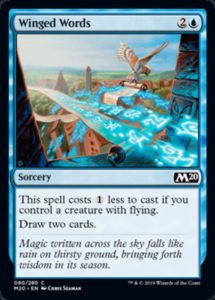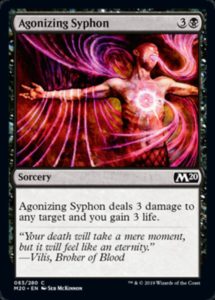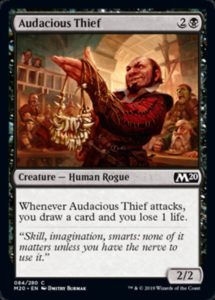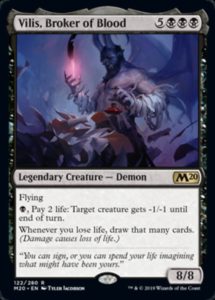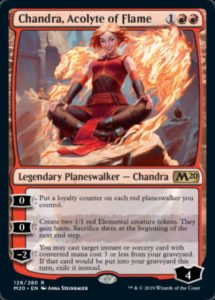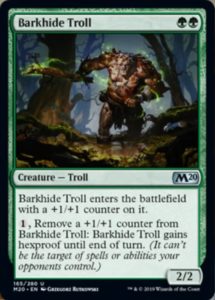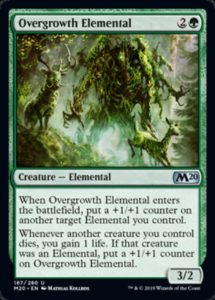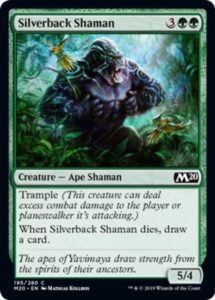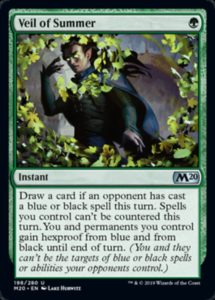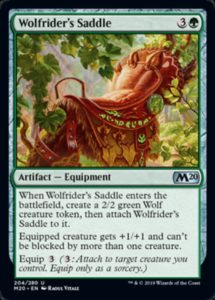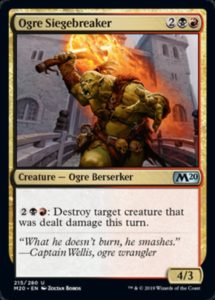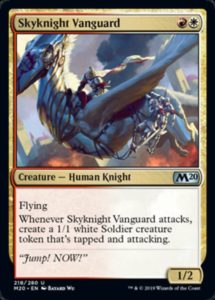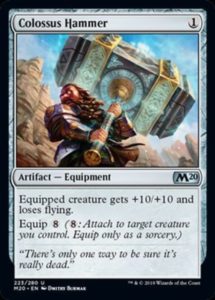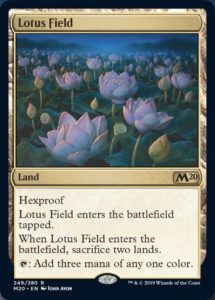Core Set 2020 is out, meaning we’ve got a whole slew of new cards to play with! We’ve got a brief reprieve from spoiler season until San Diego Comic Con this weekend, when Mark Rosewater will reveal information and presumably cards from the fall set. After that, spoilers should be done for a month or so until Commander season begins.
Today, we’ll go over the most interesting, exciting, and unusual designs in Core Set 2020, and there are a whole bunch. It’s got riffs on the Reserved List, banned cards, and some classic designs. Let’s jump right in!
Ancestral Blade is a beautifully-designed Magic card. Neither Leonin Scimitar nor Traveling Philosopher are particularly exciting or powerful, but they’re eminently serviceable. Staple them together, and you get a solid combination.
Now, we’ve seen something like this before in New Phyrexia’s Living Weapon, but that’s a mechanic very much tied to New Phyrexia (or at least the color black). By removing the mechanic, the designers get to generate different types of tokens. The addition of colored mana also allows this card to be more powerful, so you get both a better creature than Mortarpod provides as well as a more aggressive equip cost. There’s a lot of smart design that’s gone into this relatively simple card.
So often, we’re told that white is the color that doesn’t like to kill, but will if it has to. Then we see violent destructive spells like Neck Snap or Righteous Blow. Eternal Isolation is a nice twist on Reprisal (that profitably hits all of the God-Eternals) whose flavor is so non-violent. Sure, the Prometheus stand-in certainly doesn’t like his imprisonment, but at least it’s a better fate than white often seems to dole out.
I never expected to see Disenchant again in Standard. Green is supposed to be the best at Disenchant effects, and yet white has continually gotten cards to rival Naturalize. Heck, even in this set, white gets a far better card than green’s Natural End. This sends a bit of mixed messaging as to whether green or white is supposed to superior at the effect. It might not matter, because both colors can be great at the effect and green recently got Return to Nature in War of the Spark.
The pendulum has swung back around and Bone to Ash is allowed to be a common again. It is a much fairer card than Dismiss.
I never expected to see Dig Through Time again in Standard. Sure, it managed to be balanced enough to not completely break Standard, but it was an incredibly powerful card. If you told me it’d be reprinted as a sorcery without Delve, I don’t think I’d guess that it woud cost four mana. But looking at it, it makes sense—Chart a Course and Winged Words have demonstrated that you can get better than Divination at sorcery speed, and we’ve had Glimmer of Genius and Chemister’s Insight have been highly potent four mana draw spells.
Is it that crazy that adding a single blue mana to Divination gives you ridiculously good card selection? Maybe, but time will tell, and I’ve been impressed by Play Design’s ability to balance cards that look too strong.
This card looked great to me when I first saw it, but I grew up in the era of Jayemdae Tome. It’s stronger than Azure Mage and has a clear Standard deck to fit into, but four mana is a bigger cost today then it used to be. Still, it seems like an incredibly pushed card given that it has two super-relevant keyword abilities and two relevant creature types.
Looks like the actual cost of Divination effects with small hoops is about 2.5 mana. Winged Words is likely weaker than Chart a Course—it’s debatable which card’s hoop is to jump through, but being always castable for two mana is superior to only being sometimes so. This and Spectral Sailor make me wonder what other effects are going to lose a mana cost—I wouldn’t be shocked to see a Stoic Rebuttal with an easier hoop in the next year.
It’s cool seeing the various iterations in this vein. We’ve seen Essence Drain as a strictly worse version, Essence Extraction and Dark Nourishment as instant speed versions, Lightning Helix as the maximally pushed version, and the new Smiting Helix as a cool hodgepodge of them all. In today’s era of stronger and more exciting commons, this is a fair but unexciting costing for this effect.
I love me a Scroll Thief and I love me a Phyrexian Rager. This is a simple, brutally potent design that I’m kind of shocked we’ve never seen before. It can completely take over a game by itself (like Scroll Thief), it only needs to attack to get its trigger (unlike Scroll Thief), and it at least gives the opponent an opportunity to one-for-one it (unlike Phyrexian Rager). On the other hand, I wonder if this effect really should be in black—I’d expect to see more non-blue twists on Ophidian in green, not blue, and we’ve not seen such experiments much lately.
This is the kind of card that really, really feels like it should be mythic rare. That’s not a knock against the card—it’s very cool—but we’ve had a whole bunch of cards get downshifted to rare in War of the Spark. Similarly, there simply wasn’t room in Core Set 2020 when each color had only two mythic slots and they were reserved for a Planeswalker and a Cavalier.
As far as demon designs go, this is a very sweet one. It looks like all-upside when it’s in fact only mostly upside. Yes, you’re very, very likely to win the game when you untap with Vilis; but overuse of him could bring you within striking distance of a sudden death. Also, because his activated ability requires mana, he’s both very powerful and not as bonkers when cheated into play as his contemporaries.
Chandra, Acolyte of Flame is an interesting design in that it plays in areas that Chandra has focused on less. Chandra most commonly has direct damage, mass damage, and impulsive draw effects—all absent on this card. We’ve seen her make elementals once before (on Chandra, Flamecaller) and we’ve seen her cast spells from graveyards once, as well (on Chandra Ablaze, though we’ve also seen her copy spells on Chandra, the Firebrand). These two abilities make sense for her in that they’re both part of her power suite and they represent the monks of Regatha trying to teach Chandra magic that’s not best suited for her.
The weirdest ability is the first one, since not only has Chandra never added loyalty counters before, but we’ve never even seen this effect in red. We’ve only ever seen Ajani do that. This could be a color bleed or this effect could be added to red’s slice of the color pie. Still, the story behind the ability is odd—it took a long time for Chandra to learn how to operate as part of a team, after all. Then again, there might be a cute-but-sad story here in that Chandra was always good at teamwork, just only with red Planeswalkers, of which she knew none.
Trolls have long been associated with Regeneration and Hexproof. The former ability has been long since retired and the latter is problematic developmentally. Here we see a new take on troll-protection in the Troll being able to slough off damage (and its skin) once. The design is clearly a potent one, since it’s a Kalonian Tusker (already a solid threat) with upside. I don’t expect to see terribly many trolls with this exact ability, but it’s interesting seeing how trolls are branching out with new protection powers.
I’m not sure how to feel about the design of Overgrowth Elemental. As a Limited build-around, it’s a very strong card but one that needs support in order to really shine—the precise kind of build-around I love. As a card design, it’s purely mechanical with 2.5 distinct abilities. This card looked difficult to parse before playing with it, but even remembering the lifegain trigger is easier than I thought.
Here we have an example of extremely efficient costing and the improvement of commons. Green has long had commons like a vanilla 5/5 (trample usually costs an extra point of mana or a loss of a point of toughness). Now, green can not only get a 5/4 trample at common, it gets one with a built-in two-for-one.
The question Silverback Shaman brings to mind is how much a delayed card draw costs. In general, drawing a card immediately is worth two mana. I wouldn’t be surprised if a delayed trigger makes it only cost one mana (as in cards like Kingfisher). I wouldn’t ever expect to see a four mana 5/4 trample at common (at least, not anytime soon); but this is also a good example that as a card’s mana cost increases, there is more room to squeeze in extra power. Sure, increasing a card’s cost from one to two is literally doubling, while increasing it from five to six is only a 20% increase in cost; but six mana isn’t always achievable whereas two mana is extremely achievable, and so pushing value into cheaper cards is more dangerous. Food for though.
And now we’ve reached the card that was clearly developed with specific Constructed applications in mind. There’s a ton of value packed into this card’s overstuffed text box, but it also makes the card difficult to parse. This underscores a tradeoff that game designers always have to consider—do we make the card read cleanly but have some rules ambiguity, or do we have the card be technically clear but be difficult to grok? As a competitive game, Magic has leaned very heavily into the latter, and it really shows in this card. Veil of Summer actually has four different abilities. Without rereading the card, take a moment and see if you can remember them all correctly.
…
…
…
So, they are:
- If your opponent has cast a blue or black spell this turn, you get to draw a card.
- Your spells can’t be countered this turn. This applies not only apply to blue counterspells, but also stops Chalice of the Void, Red Elemental Blast, and Warping Wail.
- You gain hexproof from blue and black this turn. Get wrecked, Thoughtseize!
- Your permanents gain hexproof from blue and black. Get wrecked,Murder!
This is a really powerful card, seeing as it does four different things and should always cantrip when it’s put into your deck. But it’s got that mish-mash of text and related-but-different abilities that makes it feel like an extremely developed card, rather than a clean design.
I am mildly uncomfortable with putting a saddle on some of my creatures, but who I am to stand in the way of them doing what they love?
This is absolutely a black/red ability, but it’s not particularly effective as a signpost uncommon, since the black/red strategy is attacking. Yes, this makes it so your cheap creatures retain value over time, and yes, it’s nice seeing a BR creature that’s not another enabler for a sacrifice strategy; but this could’ve done more than make deciding how to block difficult.
I kind of love the interaction of this card’s story and the gameplay. Sure, when this works well, it will win the game, but oftentimes you’ve just got a legionnaire repeatedly sending hapless soldiers to their doom, and all because some jerk Planeswalker is making them plink the opponent.
This is an excellent example of trinket text that is clearly communicated via the artwork. It’s a massive, magically-enchanted hammer that can be held by anyone, but there’s no way you’re getting off the ground while you’re holding a skyscraper. Compare this to the original loses-flying equipment, Magebane Armor, which is apparently heavy but only because the rules say it is (and something like Argentum Armor isn’t).
It’s pretty cool seeing something that’s so clearly a riff on a Reserved List card, but also has so many distinctions. Lotus Vale has no tempo loss (since it enters the battlefield untapped, unlike Lotus Field) but incurs a lot of risk. Lotus Field doesn’t care about sacrificing untapped lands and it has no awkward “if this would enter the battlefield” text. These distinctions might seem small, but collectively they make the two cards substantially distinct and so allow Lotus Field to exist despite Lotus Vale and all functional reprints being off limits. It’s exciting to think about what other cards on the Reserved List that have yet to be riffed on might get a second chance in the future.
And there you have it, some of the most notable and interesting designs of Core Set 2020. Hopefully you’ve enjoyed this deep dive into the new format. Until then, keep designing, and as always, thanks for reading.
—Zachary Barash is a New York City-based game designer and the commissioner of Team Draft League. He designs for Kingdom Death: Monster, has a Game Design MFA from the NYU Game Center, and does freelance game design. When the stars align, he streams Magic (but the stars align way less often than he’d like).
His favorite card of the month is Tajuru Pathwarden. It’s a unique combination of numbers that’d never been done before in quite that way and was one of a few cards that turned green from the worst color in Battle for Zendikar into one of the stronger colors in Oath of the Gatewatch. It can be really nice when a french vanilla creature does a lot of work.

